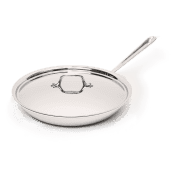Roast Whole Turkey Breast with Gravy
A perfectly cooked, crispy-skinned turkey breast can be just the ticket for a smaller holiday gathering—particularly if it comes with gravy.
Gather Your Ingredients
Key Equipment
Before You Begin
Note that this recipe requires refrigerating the seasoned breast for 24 hours. This recipe was developed using Diamond Crystal Kosher Salt. If you use Morton Kosher Salt, which is denser, reduce the salt in step 2 to 2 1/2 teaspoons, rubbing 1 teaspoon of salt into each side of the breast and 1/2 teaspoon into the cavity. If you’re using a self-basting (such as a frozen Butterball) or kosher turkey breast, do not salt in step 2. If your turkey breast comes with the back removed, you can skip making the gravy or substitute 1 pound of chicken wings for the turkey back.
Instructions
1.
Place turkey breast on counter skin side down. Using kitchen shears, cut through ribs, following vertical line of fat where breast meets back, from tapered end of breast to wing joint. Using your hands, bend back away from breast to pop shoulder joints out of sockets. Using paring knife, cut through joints between bones to separate back from breast. Reserve back for gravy. Trim excess fat from breast.
2.
Place turkey breast, skin side up, on counter. Using your fingers, carefully loosen and separate turkey skin from each side of breast. Peel back skin, leaving it attached at top and center of breast. Rub 1 teaspoon salt onto each side of breast, then place skin back over meat. Rub 1 teaspoon salt onto underside of breast cavity. Place turkey on large plate and refrigerate, uncovered, for 24 hours.
3.
Adjust oven rack to middle position and heat oven to 325 degrees. Pat turkey dry with paper towels. Place turkey, skin side up, in 12-inch ovensafe skillet, arranging so narrow end of breast is not touching skillet. Brush melted butter evenly over turkey and sprinkle with 1 teaspoon salt. Roast until thickest part of breast registers 130 degrees, 1 to 1 1/4 hours.
4.
Meanwhile, heat oil in large saucepan over medium-high heat. Add reserved back, skin side down, and cook until well browned, 6 to 8 minutes. Add onion, carrot, and celery and cook, stirring occasionally, until vegetables are softened and lightly browned, about 5 minutes. Add water, thyme sprigs, and bay leaf and bring to boil. Reduce heat to medium-low and simmer for 1 hour. Strain broth through fine-mesh strainer into container. Discard solids; set aside broth (you should have about 4 cups). (Broth can be refrigerated for up to 24 hours.)
5.
Remove turkey from oven and increase oven temperature to 500 degrees. When oven reaches 500 degrees, return turkey to oven and roast until skin is deeply browned and thickest part of breast registers 160 degrees, 15 to 30 minutes. Using spatula, loosen turkey from skillet; transfer to carving board and let rest, uncovered, for 30 minutes.
6.
While turkey rests, pour off fat from skillet. (You should have about 1/4 cup; if not, add extra oil as needed to equal 1/4 cup.) Return fat to skillet and heat over medium heat until shimmering. Sprinkle flour evenly over fat and cook, whisking constantly, until flour is coated with fat and browned, about 1 minute. Add wine, whisking to scrape up any browned bits, and cook until wine has evaporated, 1 to 2 minutes. Slowly whisk in reserved broth. Increase heat to medium-high and cook, whisking occasionally, until gravy is thickened and reduced to 2 cups, about 20 minutes. Season with salt and pepper to taste. Carve turkey and serve, passing gravy separately.





0 Comments
Posting GuidelinesFROM OUR TV SPONSORS
We are thankful to the sponsors who make it possible for us to bring you the America's Test Kitchen TV series on public television. Read more about why we have sponsors.